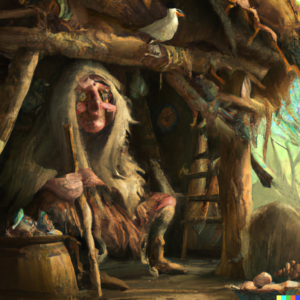Baba Yaga: The Mysterious Witch of Slavic Folklore
1st April 2023
Categorized Under: Myths and Legends from Around the World
Comments (0)
BABA YAGA: THE MYSTERIOUS WITCH OF SLAVIC FOLKLORE
Deep in the heart of a dark forest, there was a hut on chicken legs that belonged to the fearsome Baba Yaga. Her name sent shivers down the spine of every child in the nearby villages, for she was known as the witch who ate children. Baba Yaga was not like any other witch. She was ancient and twisted, with iron teeth and long, tangled hair. Her eyes glowed like hot coals, and her cackling laugh echoed through the trees. But there was more to Baba Yaga than her fearsome reputation. She was a powerful sorceress who guarded the secrets of the forest and was sought after by those in need of her magic.
One day, a young girl named Vasilisa found herself lost in the forest. As she wandered deeper into the woods, she stumbled upon the hut on chicken legs. The sight of the hut both frightened and intrigued her, and she cautiously approached the door. Just as she was about to knock, the door swung open, and Baba Yaga appeared.
“What do you want, child?” Baba Yaga snarled.
“I am lost in the forest and need your help,” Vasilisa replied, trying to hide her fear.
Baba Yaga looked at Vasilisa with her piercing gaze, and after a moment, she let out a wicked cackle.
“I will help you, but only if you agree to do as I say,” Baba Yaga said, revealing her iron teeth.
Vasilisa knew that Baba Yaga’s help would come at a price, but she had no other choice. She agreed to Baba Yaga’s terms and followed the witch into her hut.
Inside, Vasilisa found herself surrounded by darkness and a pungent smell of herbs and magic. Baba Yaga gave her a list of impossible tasks to complete, including sorting a huge pile of grain, cooking a feast, and cleaning the hut. Vasilisa worked tirelessly, and much to her surprise, the help of three magical dolls she received from Baba Yaga made the tasks much easier.
As the night wore on, Baba Yaga grew increasingly agitated, for Vasilisa had completed all the tasks set before her. Finally, the witch relented and rewarded Vasilisa with a glowing skull filled with a magical flame that would light her way out of the forest.
Vasilisa made her way back to her village, where her stepmother and stepsisters had been worried sick about her. She told them of her encounter with Baba Yaga and how she had successfully completed the impossible tasks. The three dolls she had received from Baba Yaga became cherished possessions, and the glowing skull she had received became a symbol of hope and guidance for all who were lost in the forest. As for Baba Yaga, she continued to haunt the forest, feared by many but revered by those who sought her magical knowledge. Her legend grew, and tales of her power and cunning spread far and wide, serving as a warning to those who dared to cross her path.
The story of Baba Yaga is a fascinating and complex one, full of darkness, mystery, and magic. It reminds us that sometimes, the most unlikely allies can offer the greatest help and that even the most fearsome of creatures can have a heart. While Baba Yaga may be a terrifying figure, her role as a guardian of the forest and a keeper of ancient knowledge is an important one, and her legacy continues to inspire generations of storytellers and artists.
FACTS YOU PROBABLY DIDN’T KNOW ABOUT BABA-YAGA:
-
Baba Yaga is not just one single entity, but a complex figure in Slavic folklore that can take on different forms and personalities. She is often depicted as a wrinkled old woman with wild hair and iron teeth, but can also appear as a beautiful young maiden or a fierce, bird-like creature.
-
Baba Yaga is often associated with the elements of fire and water, and is said to have control over the weather, particularly storms and winds.
-
Baba Yaga’s iconic hut on chicken legs is said to be a symbol of her connection to the natural world, as the hut can move and change location at will, much like the animals and plants in the forest.
-
Baba Yaga is not always a villain in Slavic folklore, and is sometimes seen as a wise and benevolent figure who offers guidance and assistance to those who seek her out.
-
The name “Baba Yaga” is derived from the Russian words “baba,” meaning old woman, and “yaga,” which can be translated as “witch” or “disease.” In some Slavic languages, “yaga” is also associated with the word for “snake,” further emphasizing Baba Yaga’s connection to the natural world.
-
Baba Yaga is often depicted as a trickster figure, using her magical powers to play pranks on those who cross her path. In some stories, she tests the moral character of her visitors, rewarding those who pass her tests with her magical assistance.
-
Baba Yaga’s role in Slavic mythology and folklore has influenced many works of art and literature, including the famous ballet “The Firebird” by Igor Stravinsky and the novel “Deathless” by Catherynne M. Valente.
ASPECTS OF BABA YAGA’S CHARACTER AND MYTHOLOGY THAT REMAIN UNCLEAR OR UNEXPLAINED. SOME OF THESE MYSTERIES INCLUDE:
-
Baba Yaga’s origins: It is not entirely clear where Baba Yaga came from or how she became such a prominent figure in Slavic mythology. Some scholars have suggested that she may have originated from ancient pagan beliefs or pre-Christian folklore, while others believe that she may have been inspired by historical figures or events.
-
Baba Yaga’s motivations: In many stories, it is not clear why Baba Yaga does what she does or what her ultimate goals are. She is often portrayed as a capricious figure who acts according to her own whims and desires, making her difficult to understand or predict.
-
The meaning of Baba Yaga’s symbolism: Many of Baba Yaga’s characteristics and symbols have deep symbolic meaning, but the exact significance of these symbols is not always clear. For example, her hut on chicken legs may represent her connection to nature and the cycles of life and death, but the full extent of this symbolism is not known.
-
Baba Yaga’s relationship to death: Baba Yaga is often associated with death and the underworld, but the nature of this connection is not fully understood. Some believe that she is a guardian of the dead or a psychopomp*, guiding souls to the afterlife, while others believe that she is a bringer of death and disease.
These mysteries only add to the intrigue and mystique surrounding Baba Yaga, making her a truly fascinating and enigmatic figure in Slavic folklore.
** “Psychopomp” is a term used to describe a supernatural being or deity that is responsible for guiding souls to the afterlife. The term comes from the Greek words “psyche” (meaning soul) and “pompos” (meaning guide or conductor), and refers to a figure that serves as a bridge or intermediary between the living and the dead. In many mythologies and religions around the world, psychopomps are believed to play a crucial role in helping souls navigate the afterlife and reach their final destination. Some examples of psychopomps in various mythologies include Anubis in Egyptian mythology, Hermes in Greek mythology, and the Valkyries in Norse mythology.
CAN BABA YAGA BE KILLED?
In Slavic folklore, there is no definitive answer to whether Baba Yaga can be killed or not. While she is often portrayed as a powerful and immortal figure, there are some stories in which she is defeated or overcome by clever trickery or by the hero’s bravery.
There are also various ways in which Baba Yaga can be appeased or made to disappear. In some tales, the hero must complete a series of seemingly impossible tasks in order to win Baba Yaga’s favor or to get what they want from her. Other stories suggest that Baba Yaga can be distracted or tricked into leaving, or that she can be appeased with offerings of food, gifts, or other items.
It is important to note, however, that Baba Yaga is a complex and multifaceted figure in Slavic folklore, and her actions and motivations can vary widely depending on the specific story or context.
WHEN DID THE LEGEND BEGAN?
The exact origins of Baba Yaga and the legend surrounding her are unclear and difficult to trace. However, it is believed that the Baba Yaga figure may have originated from ancient pagan beliefs and pre-Christian Slavic folklore.
Some scholars have suggested that Baba Yaga may have been inspired by ancient goddesses or spirits of nature, while others believe that she may have been influenced by historical figures or events. The name “Baba Yaga” itself is derived from the Slavic word “baba”, which means “old woman”, and “yaga”, which may be related to the word for “witch”.
Baba Yaga’s prominence in Slavic folklore likely grew over time, as her stories were passed down through generations and adapted to reflect the changing cultural and political landscape of the region. Today, Baba Yaga remains an important and enduring figure in Slavic mythology, inspiring countless tales, works of art, and other cultural artifacts.
@ K I D S I N C O
Click here to read: Kidsinco’s Myths and Legends from Around the World
Click here to read: Kidsinco’s Complete List of Playscripts
Please read our: Terms of Use
Tags: Baba Yaga myth, Baba Yaga story, Slavic folklore



